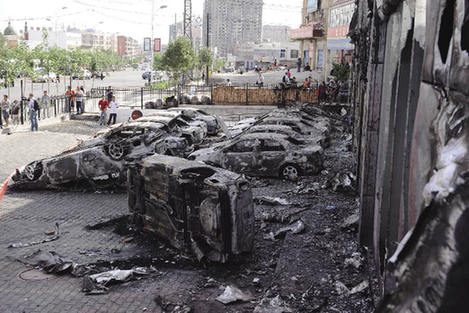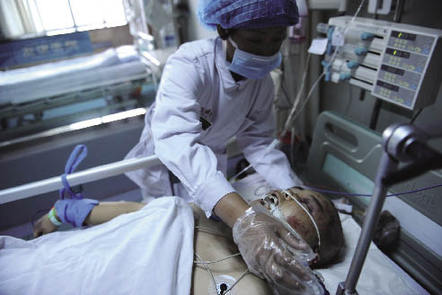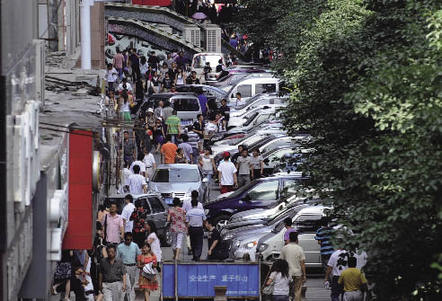| Urumqi Riot: Backstory
|

|
|
A 4S car dealership in Urumqi was completely gutted. |
On July 5 deadly violence erupted in Urumqi,the capital of Xinjiang Uygur Autonomous Region in China's far west,killing 192 people and wounding 1,721 others, according to statistics up to July 15. A total of 627 vehicles and 633 buildings were damaged. The nation was overwhelmed with shock at the wrath displayed. In the early morning of July 8, President Hu Jintao cut short his G8 summit trip to return to Beijing, where he chaired an emergency meeting of the CPC Political Bureau Standing Committee, convened to address maintaining social stability in Xinjiang.
A Bloody Crime
July 5 started as any other typically quiet Sunday on the People's Square in downtown Urumqi. People streamed through the square, while tourists took pictures by the Peaceful Liberation of Xinjiang Monument, a token of the area's inter-ethnic fraternity.
At around 6 pm, things changed when a large group of people appeared on the site. Most of those in the swelling crowd were young, angry males, who soon lost control. By 8 pm the gathering had escalated into a killing and burning rampage. Rabid mobs spilled across the city, beating and stabbing innocent pedestrians, looting and torching local shops, restaurants and homes, and smashing and scorching any vehicle in their path, whether public or private.
Kadeliya, a 23-year-old Uygur girl, was on her way home by bus when rioters blocked the road. The driver opened the door, urging passengers to run for cover. She had barely set her foot on the ground when her head was hit by a club. Kadeliya was later rushed to the hospital by aid workers dispatched to the site.
"The thugs hacked at everyone they met and set fire to every car they saw. They are absolutely inhuman," recalled fruit vendor Aimudula, who lives along Houquan Road, epicenter of the riot. His family resides in a courtyard compound of 17 families from different ethnic backgrounds, all of whom have traditionally maintained warm ties. Aimudula is content with his business, although it brings in only around RMB 100 everyday. He yearns for nothing except peace and security for his wife and children. His wife fainted at the sight of the macabre scenes.
|

|
|
By July 15, the violence had resulted in 192 deaths and 1,721 injuries. |
Synchronized with the Urumqi commotion, Eastern Turkish separatist groups abroad staged separate attacks on the Chinese diplomatic missions in the Netherlands, Germany, Australia, Turkey, Sweden, Norway and Japan, threatening their staff's safety and damaging their property.
On July 7 at 2 pm local time in Washington D.C., Rebiya Kadeer, head of the World Uyghur Congress (WUC), and 150 or so of her followers marched to the Chinese embassy, wielding the Xinjiang independence flag and signboards, and chanting slogans such as "Liberation for East Turkistan." The U.S. police managed to thwart the protestors' attempts to assail the embassy.
The False Trigger
In his television speech on July 6 Xinjiang Chairman Nur Bekri blamed three hostile forces overseas for the upheaval – religious extremists, national separatists and international terrorists – for manipulating the workers' dispute at a factory in Shaoguan, Guangdong Province, to ferment and organize the July 5 riots.
Everything started with a fight in Xuri, a Hong Kong-funded toy company based in Shaoguan City, whose staff members exceed 18,000. In response to the government's call of taking in surplus labors from the less developed western regions, the company hired some 700 farmers in Shufu County in Xinjiang early this year. In mid-June someone posted a message on a local website sg169.com, saying six Xinjiang boys raped two girls. It soon found its way to many other websites, seeding resentment among some Xuri workers against their Xinjiang colleagues. When a couple of Xinjiang workers teased a female intern at the factory in the evening of June 26, some other workers confronted them. Soon the spat swirled into a melee involving hundreds of people, and concluding with the death of two Xinjiang workers and injury of 120 others. By July 5, 13 suspects had been arrested, including three from Xinjiang.
The police investigation found that there was no rape in the toy company. In fact there has been no reported rape cases in whole Wujiang District of Shaoguan, where the company is located, since last May. On June 28, a man with the surname Zhu was arrested, and soon confessed that he posted false information of the rape on-line. A former employee of the company, Zhu tried to resume his job after resignation, but was rejected. Filled with venom, he spread word of the spurious rape in revenge.
Ptiguli, sister of Aximujiang Aimaiti, who was killed in the factory fight, condemned those who stirred up violence in her brother's name, which left more families bereaved. She said the remains of her brother and the other victim were sent to Xinjiang with government assistance on June 29, and buried in their hometowns in line with Uygur customs.
Wang Lequan, Party Secretary of Xinjiang, pronounced: "Hostile forces abroad and a handful of rogues at home tried every means to hype the factory skirmish in Guangdong in order to fan ethnic enmity. Hostile forces in China and abroad are scheming big to sabotage ethnic solidarity, agitate ethnic friction and scuttle social stability."
Police intercepted phone calls between the WUC and its members in China, which revealed that the group masterminded the July 5 Riot. The WUC also closely followed the aftermath of the incident through e-mails with its members in China, egging them on to "be bold," and "do something big."
Foreign Ministry spokesman Qin Gang told a news conference: "More and more people in the international community will recognize this as an act of terrorism and a deliberate attempt of the Eastern Turkish separatist forces to undermine national unity and provoke divisions in China.
The turmoil in Xinjiang aroused wide concern within and outside of China. State Councilor and Public Security Minister Meng Jianzhu flied to Urumqi on July 8 to bring condolences to the victims and their families. On the morning of that day the traffic curfew was lifted. Bus transport soon resumed 80 percent of its previous volume. Factories resumed production, and stores and restaurants reopened. Repair work started on infrastructures shattered by rioters. The local economy and life gradually and steadily slid back to normal.
The Urumqi municipal government pledged to cover the full medical and living expenses of riot victims as well as to provide some compensation for property loss. For this purpose the city of 2.3 million residents raised a comfort fund of RMB 100 million.
|
 |
|
Peace has returned to Urumqi, as seen in this picture taken on July 10. |
One week after the riot, streets in downtown Urumqi were once again animated with the flow of vehicles and pedestrians. Jostling crowds have reappeared in bazaars and shopping malls. Peace has returned to the city.
Related:
Xinjiang Uygur Autonomous Region
China's Policies Towards Ethnic Minorities
| 